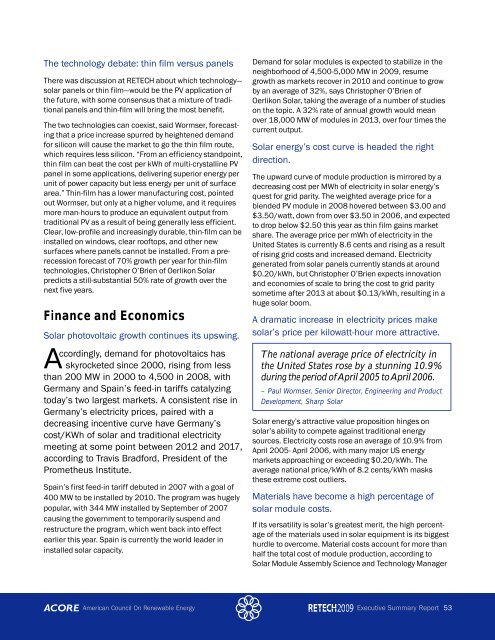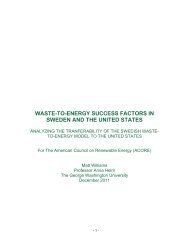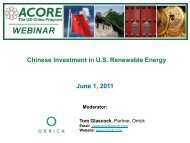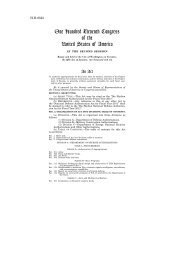Read More - American Council On Renewable Energy
Read More - American Council On Renewable Energy
Read More - American Council On Renewable Energy
Create successful ePaper yourself
Turn your PDF publications into a flip-book with our unique Google optimized e-Paper software.
The technology debate: thin film versus panelsThere was discussion at RETECH about which technology—solar panels or thin film—would be the PV application ofthe future, with some consensus that a mixture of traditionalpanels and thin-film will bring the most benefit.The two technologies can coexist, said Wormser, forecastingthat a price increase spurred by heightened demandfor silicon will cause the market to go the thin film route,which requires less silicon. “From an efficiency standpoint,thin film can beat the cost per kWh of multi-crystalline PVpanel in some applications, delivering superior energy perunit of power capacity but less energy per unit of surfacearea.” Thin-film has a lower manufacturing cost, pointedout Wormser, but only at a higher volume, and it requiresmore man-hours to produce an equivalent output fromtraditional PV as a result of being generally less efficient.Clear, low-profile and increasingly durable, thin-film can beinstalled on windows, clear rooftops, and other newsurfaces where panels cannot be installed. From a prerecessionforecast of 70% growth per year for thin-filmtechnologies, Christopher O’Brien of Oerlikon Solarpredicts a still-substantial 50% rate of growth over thenext five years.Finance and EconomicsSolar photovoltaic growth continues its upswing.Accordingly, demand for photovoltaics hasskyrocketed since 2000, rising from lessthan 200 MW in 2000 to 4,500 in 2008, withGermany and Spain’s feed-in tariffs catalyzingtoday’s two largest markets. A consistent rise inGermany’s electricity prices, paired with adecreasing incentive curve have Germany’scost/KWh of solar and traditional electricitymeeting at some point between 2012 and 2017,according to Travis Bradford, President of thePrometheus Institute.Spain’s first feed-in tariff debuted in 2007 with a goal of400 MW to be installed by 2010. The program was hugelypopular, with 344 MW installed by September of 2007causing the government to temporarily suspend andrestructure the program, which went back into effectearlier this year. Spain is currently the world leader ininstalled solar capacity.Demand for solar modules is expected to stabilize in theneighborhood of 4,500-5,000 MW in 2009, resumegrowth as markets recover in 2010 and continue to growby an average of 32%, says Christopher O’Brien ofOerlikon Solar, taking the average of a number of studieson the topic. A 32% rate of annual growth would meanover 18,000 MW of modules in 2013, over four times thecurrent output.Solar energy’s cost curve is headed the rightdirection.The upward curve of module production is mirrored by adecreasing cost per MWh of electricity in solar energy’squest for grid parity. The weighted average price for ablended PV module in 2008 hovered between $3.00 and$3.50/watt, down from over $3.50 in 2006, and expectedto drop below $2.50 this year as thin film gains marketshare. The average price per mWh of electricity in theUnited States is currently 8.6 cents and rising as a resultof rising grid costs and increased demand. Electricitygenerated from solar panels currently stands at around$0.20/kWh, but Christopher O’Brien expects innovationand economies of scale to bring the cost to grid paritysometime after 2013 at about $0.13/kWh, resulting in ahuge solar boom.A dramatic increase in electricity prices makesolar’s price per kilowatt-hour more attractive.The national average price of electricity inthe United States rose by a stunning 10.9%during the period of April 2005 to April 2006.– Paul Wormser, Senior Director, Engineering and ProductDevelopment, Sharp SolarSolar energy’s attractive value proposition hinges onsolar’s ability to compete against traditional energysources. Electricity costs rose an average of 10.9% fromApril 2005- April 2006, with many major US energymarkets approaching or exceeding $0.20/kWh. Theaverage national price/kWh of 8.2 cents/kWh masksthese extreme cost outliers.Materials have become a high percentage ofsolar module costs.If its versatility is solar’s greatest merit, the high percentageof the materials used in solar equipment is its biggesthurdle to overcome. Material costs account for more thanhalf the total cost of module production, according toSolar Module Assembly Science and Technology Manager<strong>American</strong> <strong>Council</strong> <strong>On</strong> <strong>Renewable</strong> <strong>Energy</strong>Executive Summary Report 53













